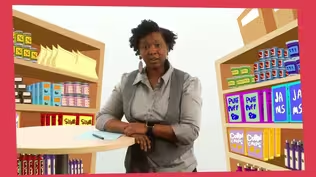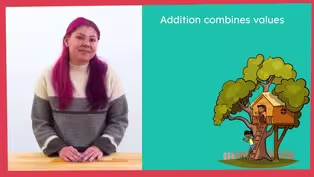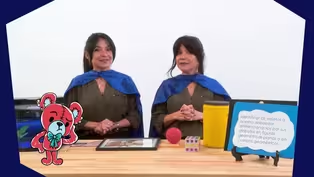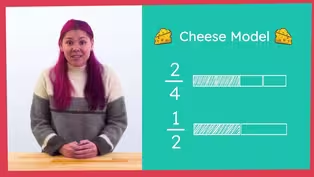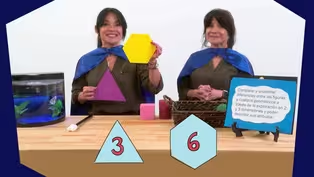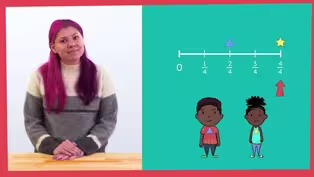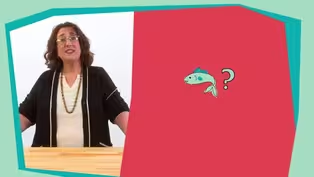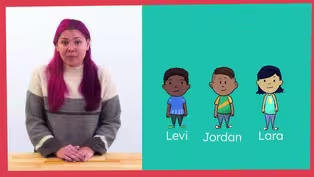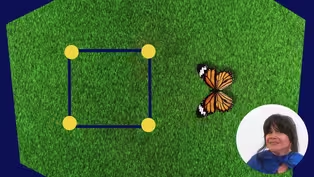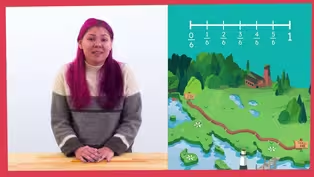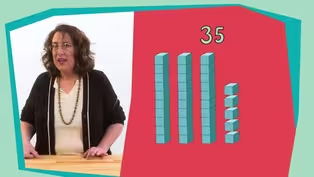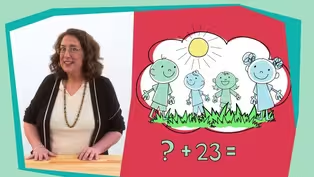
Episode 46 | Math Lessons
5/17/2021 | 28m 46sVideo has Closed Captions
Math lessons for early learners, led by NC teachers.
The first lesson (aimed at 3rd graders) teachers students how to solve unknown factor problems. The second lesson (also aimed at 3rd graders) explores two-step word problems using addition, subtraction, and multiplication. Classroom Connection is your At-Home Learning companion where children love to learn. All lessons are led by NC educators.
Problems playing video? | Closed Captioning Feedback
Problems playing video? | Closed Captioning Feedback
At-Home Learning Presents: Classroom Connection is a local public television program presented by PBS NC

Episode 46 | Math Lessons
5/17/2021 | 28m 46sVideo has Closed Captions
The first lesson (aimed at 3rd graders) teachers students how to solve unknown factor problems. The second lesson (also aimed at 3rd graders) explores two-step word problems using addition, subtraction, and multiplication. Classroom Connection is your At-Home Learning companion where children love to learn. All lessons are led by NC educators.
Problems playing video? | Closed Captioning Feedback
How to Watch At-Home Learning Presents: Classroom Connection
At-Home Learning Presents: Classroom Connection is available to stream on pbs.org and the free PBS App, available on iPhone, Apple TV, Android TV, Android smartphones, Amazon Fire TV, Amazon Fire Tablet, Roku, Samsung Smart TV, and Vizio.
Providing Support for PBS.org
Learn Moreabout PBS online sponsorshipMore from This Collection
Math lessons for early learners, led by NC teachers.
Video has Closed Captions
Math lessons for early learners, led by NC teachers. (28m 46s)
Video has Closed Captions
Math lessons for early learners, led by NC teachers. (28m 46s)
Video has Closed Captions
Math lessons for early learners, led by NC teachers. (28m 46s)
Video has Closed Captions
Math lessons for early learners, led by NC teachers. (28m 46s)
Video has Closed Captions
Math lessons for early learners, led by NC teachers. (28m 46s)
Video has Closed Captions
Math lessons for early learners, led by NC teachers. (28m 46s)
Video has Closed Captions
Math lessons for early learners, led by NC teachers. (28m 46s)
Video has Closed Captions
Math lessons for early learners, led by NC teachers. (28m 46s)
Video has Closed Captions
Math lessons for early learners, led by NC teachers. (28m 45s)
Video has Closed Captions
Math lessons for early learners, led by NC teachers. (28m 46s)
Video has Closed Captions
Math lessons for early learners, led by NC teachers. (28m 45s)
Video has Closed Captions
Math lessons for early learners, led by NC teachers. (28m 46s)
Providing Support for PBS.org
Learn Moreabout PBS online sponsorship[cheerful upbeat music] ♪ - Thank goodness for today's math lesson.
Math is so important because without it I wouldn't know how many days there are until my birthday.
There are 182 days until my birthday.
How about you?
Let's get into some math to stress those brains.
Here we go.
- Hi mathematicians.
It's me, Ms. Altman, and it's amazing to see you.
Before we get started, let's take 20 seconds to grab some supplies that we will need for our time together today.
You will need paper and a pencil.
I'm going to go and get mine.
Why don't you go ahead and do the same.
See you in a little bit!
[bright upbeat music] Okay, we're back, and oh my goodness.
Look where we are!
We're in the grocery store!
And do you know what?
The grocery store managers heard that we are amazing mathematicians.
So they asked if we might help them figure out how to display the cereal inventory on their shelves.
Can you help me?
You can?
Oh, wonderful!
Thank you so much.
I'm wondering how we might inventory all of these boxes of cereal.
Do you think we could use a math strategy to help us?
You do?
Great, I think so too.
Today, we're going to learn how to use inverse operations to help us solve problems.
You may be thinking what are inverse operations?
Make a prediction about what you think inverse operations mean.
Talk to a friend or a trusted adult.
Oh, I heard someone say that inverse operations are just a fancy way of saying opposites.
You know, like hard and soft, dry and wet or cold and hot.
I bet you didn't think about these things and math as having opposites, did you?
What's that?
Yes, that is true.
I heard someone ask if we could explain inverse operations in another way, in a more precise math way.
Absolutely!
An inverse operation reverses the effect of the first operation.
For example, addition and subtraction are inverse operations.
Let's explore inverse operations a little farther by looking at some equations.
Eight plus five equals 13 and 13 minus five equals eight.
What do you notice about these two equations?
Good thinking, I heard someone say that the two equations contain the same numbers.
What else do you notice?
Not sure?
Okay, let me help you out.
In the first equation, we started with eight and added five to it to get to 13.
And the second equation we started with 13 that's subtracted five and it gave us eight by subtracting five.
We undo our previous edition or the opposite of what we did in the first equation.
So today let's use what we know about inverse operations to solve multiplication and division problems.
Are you ready?
Let's jump in.
Take the problem, 45 divided by five for example.
Wait, what's that?
You don't wanna do a division problem today?
That's okay.
Remember we are using inverse operations today.
The inverse operation of division is multiplication.
Instead of dividing, we can use multiplication facts.
Is that okay with you?
Great.
Hm.
What times five equals 45?
What's that?
You counted by fives on your fingers until you got to 45 and you think it's nine?
Okay, let me count again with you.
You ready?
Let's count by fives using our fingers.
Five, 10, 15, 20, 25, 30, 35, 40, 45.
How many fingers am I holding up?
Yes nine.
You were correct.
Let's make an array with our cereal boxes to check.
So nine times five equals 45.
So the inverse operation will be, 45 divided by five equals nine.
Let's try another.
32 divided by four equals?
Let's write this as an inverse operation on your paper, please write the inverse of 32 divided by four.
What did you write on your paper?
Share your answer with a friend or trusted adult.
Very good.
You wrote four times something equals 32.
So we know that four times something equals 32.
Do you know a math fact for that?
You do?
Say that louder.
Yes four times eight equals 32.
Okay, let's build an array to check our thinking.
That's right, four times eight equals 32.
So 32 divided by four equals eight.
Would you like to try another one?
Great, let's try a word problem, this time.
Jamie collected 48 stickers.
Her sticker book can hold 8 stickers per page.
How many pages will she need to hold her sticker collection?
I'm gonna give you a moment to work on this problem.
You ready?
Great.
What information do we know in this problem?
That's right, we know that Jamie has 48 stickers.
What else do we know?
Yes, her sticker book can hold eight stickers per page.
How can we write this information as an equation?
If you did not write an equation, please write one down now, are you ready to share your equation?
Awesome sauce.
Let's write an equation.
Using the information that we know from the problem.
Jamie has 48 stickers and eight stickers can go on each page so we can write 48 divided by eight equals, something.
What's that repetition.
You wrote a multiplication equation.
You wrote eight times something equals 48.
That's fine, you wrote the inverse of division, which is multiplication.
And that's our strategy for today.
So how did you solve this problem?
How many pages will she need?
Yes, you are correct.
She will need six pages because six times eight equals 48.
So 48 divided by eight equals six let's review.
We can use the inverse operation or multiplication to solve division problems.
Are you ready to help with the serum display?
Great let's do this.
We have 63 boxes of cereal and they want an equal number of boxes.
All seven shelves, okay mathematician.
How many boxes of cereal should we put on each shelf?
I'm gonna give you a moment to write an equation, the inverse operation, and time to solve this problem.
[bright upbeat music] Are you ready to share your thinking mathematicians.
Great, what is our division equation to represent this problem?
You are absolutely correct.
63 divided by seven equals something.
What is the inverse operation or multiplication equation for this problem?
Right again, seven times something equals 63.
How many cereal boxes should we put on each shelf?
What's that?
Oh, no.
I need to clarify that for all of our mathematician friends, one of our mathematicians mentioned that they knew how to write the equations but they didn't know what seven times something equals 63 and they need our help.
It's okay to admit you need help because we grow by learning from our mistakes.
So let me clarify.
Create a name multiplication problem to solve a division problem is one strategy.
If you don't know the multiplication facts, just like that you can use other strategies to help you like build in an array, make it equal groups are using subtraction lets make equal groups to help solve this problem.
So what time seven equals 63.
My visual is using shifts.
There are placed in one box of cereal on each shift to make equal groups.
Now let's count how many cereal boxes are on each shelf.
Count the boxes with me.
One, two, three, four, five, six, seven, eight, nine.
There are nine cereal boxes on seven shelves.
So seven times nine equals 63.
So 63 divided by seven equals nine.
Great job mathematicians.
Thanks for joining me today.
I hope you have fun.
Learning about inverse operations, and using multiplication to solve division problems.
Remember using multiplication to solve a division problem is only one strategy.
You can still check your work by using repeated subtraction.
Building arrays or creating equal groups.
Join me next time to learn more math strategies bye mathematicians.
- Hey everyone, I hope you love numbers even more now after that awesome lesson do you have a favorite number?
I like eight.
Why?
Because it looks like a sideways infinity symbol numbers can be beautiful, just like words.
- Hi, my name is Reese and I'm gonna read you "Chicken Bedtime is Really Early."
From chickens to hamsters from rabbits to sheep, sooner or later we all need to sleep.
[chicken clucking] At five o'clock chickens get ready for bed.
Each spotted white hen and each Rhode Island Red.
[chicken clucking] The chicks take their bath, chicken moms standing near to make sure they wash behind each chicken ear.
Now fluffy and dry the chicks bounce into bed.
The mamas cluck goodnight and give pecks on the head.
So when it is six, every chick boy and girlie is snug in the coop.
Chicken bedtime is early.
[snoring] At seven it's time for the cows and the sheep to call their young into the barn for some sleep.
[cows mooing] The lambs and calves are all running and playing.
Not listening to what their mamas are saying.
One minute, the barn door is swung open wide.
Next minute it's closed with the mamas inside.
The lambs call, baa, wait, the cows call maa, moo!
The farmer, he laughs and invites them in too.
At eight and it's time for the bunnies to stop chewing and jumping and hop, hop, hop, hop.
It's time for each one of the bun-dads and mommies to put their young rabbit into footy pajamas.
Then into the rabbit hole, into the pile.
"Who kicked me?"
Says one with a mischievous smile, a story, a story, the young bunnies roar and just as it ends all the bunnies begs more.
Although they've already heard it 18 times before.
at nine O'clock, fishes are ending their day each eel, every minnow, each snapper and ray.
Those that have teeth well, they gave them a brush, those that do not well, they gargle and such.
Then some of the little fish sons and fish daughters ask why can't I have just one more glass of water?
The fish dads are stern.
No more carping, I said!
You've got school in the morning.
Come on, off to bed.
[frogs croaking] At 10, it is time for the frogs to take five and rest from the concert that they performed live the croaking and singing of songs so inspired results in the pond full of frogs, who are tired.
[yawning sounds] So frog mom and pop get the tadpoles all fed and settle them into their lily pad bed.
Then in the soft shimmering light of the moon, An old bullfrog belts one last froggy tune.
Along with the time when the hamsters takes breaths at 12, they're back up at their hamster beds.
The rest of them, they're napping all the hamsters now feel like taking a night jog on the wheel.
Now one o'clock isn't a bedtime you see.
Nor, for the matter is two or is three.
At those times most creatures are fast, fast asleep, Except for the hamsters.
What hours they keep!
At four in the morning the rooster, he rises, does pushups and curl ups with weights of all sizes.
He climbs up the fence post and crows at the sun.
Announcing to all the day has began, [rooster crows] The chicks all get up at the break of the dawn.
They walk up to their mother, who grumble and yawn.
The cows will soon get up and call, "Morning, moo!"
The bunnies will wake up and hop to it too.
Later sheep, frogs, fishes and you.
- Where y'all at?
Oh, there you are.
Yo, let's check out what we got next.
- Hello, third grade friends.
Diane here, I'm so glad to see you.
Today, we're going to be solving multi-step problems using different strategies.
Before we get started let's review what we know about the word strategies.
Let's use a Frayer Model to help us out.
Are you ready?
Let's get started to make our Frayer Model.
You will need a piece of paper and a pen, a pencil, or a marker.
I'm going to go get my supplies.
You go ahead and do the same.
[bright upbeat music] Now that we have our supplies, let's begin to make our Frayer Model.
Let's take a piece of paper and fold it in half hamburger style.
And then we're gonna fold it in half again to make four equal rectangles.
And then in the corner of our paper where all sides are folded, we're going to fold it down and make a small triangle.
When you unfold your paper, the folds should look like this.
Does yours look like mine?
Okay, great.
We're going to write the word strategies in the center diamond because this is the word we need to understand more about.
Then, in the upper left rectangle we're also going to define this term.
So let's write the word definition here.
In the upper right rectangle, we're going to provide an example of a strategy.
So let's right example here.
Then in the lower left rectangle we'll provide a non-example, or what strategies are not.
So write non-example here.
And finally in the lower right rectangle, we'll draw a picture to help us visualize what strategies are.
So let's write the word picture here to remind us of what we're supposed to do.
So now we're going to define the word strategy together.
So let's write the definition in our upper left rectangle.
A strategy is a method that can be used to solve a problem.
For example, if I wanna solve a problem involving addition and subtraction, I could use estimation, friendly numbers like tens and hundreds or other strategies to help me think through the problem.
I'm going to give you some time to write this definition in your frayer model.
As we use strategies to help us think through the math in the today's lesson you'll be able to add examples, non-examples and draw a picture to share your growing understanding.
Let's move our frayer models to the side for now.
I could really use your help with a math problem that I'm having.
I'm planning a field trip to a local farm for all of the third graders in my school.
When we get there at 9:00 AM they will load us onto shuttle vans that hold 10 riders.
How many vans should I reserve for all our students and their four teachers?
Here's the list of each class and the number of students in each class.
So Miss Jones has 19 students, Mr. Garcia has 25 students, Ms. Hiatt's has 23 students and Mr. McNeill's has 17 students.
Can you help me solve this problem?
Thank you.
The first thing I usually do when solving a problem is to try and make sense of what is happening and what I need to find out.
So let's go through some questions to better understand it.
What is happening in the problem?
Exactly.
Students are going on a field trip and have to be put into groups of 10.
Is there any extra information that we don't need?
Right.
We don't need to know what time they will arrive.
And what will the answer tell us?
Exactly.
It will tell us how many vans we need to reserve.
So about how many vans do you think we will need?
Remember, this is an estimate, not an exact number.
Okay, I heard someone say nine because each class will have about two vans plus one more for the extras.
Great, I think I understand the problem now.
Are you ready to help me solve it?
Wonderful, what should we do first?
Okay, let's find the total number of students.
What an equation could we use to find the number of students?
Yes, 19 plus 25 plus 23 plus 17.
Now, how would you solve this?
I'll give you a few moments to think about this, all right.
Can you tell me how you would solve it?
Oh wow!
Those are some great ideas.
Let me share a couple of the ones that I heard.
What else idea I heard is to break apart or decompose the numbers and add by place value.
It would look like this 10 plus 20 plus 20 plus 10 equals 60 and then nine plus five plus three plus seven equals 24, and then 60 plus 24 equals 84.
Another idea I heard is to look for ways to add, to get friendly numbers.
Remember friendly numbers are multiples of 10 or 100.
They end in a zero and are easy to add.
I'm going to add 23 and 17 first because I noticed the three and the seven, three and seven equals 10.
So 23 plus 17 equals 40.
Then I'm going to add 19 plus 25.
19 is one more than 20.
So if I add 20 and 25, that would equal 45 then I would need to take away the one that I added in 19.
So that would be 44, 40 plus 44 equals 84 students.
Okay, I feel confident that we have found the total number of students, are we finished solving our problem?
No, so let's read the problem again.
I'm planning a field trip to a local farm for all of the third graders in my school.
When we get there at 9:00 AM they will load us on to shuttle vans that hold 10 riders.
How many vans should I reserve for all of our students and their four teachers?
Okay, I know there are 84 students.
Is there any other information that I need about the number of riders?
All right, I need to include the details.
So 84 plus the four teachers would be 88.
So there are 88 total riders.
Now what do we know about the vans?
Exactly, each van holds 10 riders.
So I need to put my riders into equal groups of 10.
What equation could we use for this problem?
Right.
We're putting a total number of objects or people into equal groups of 10.
This is a division problem.
We have 88 divided by 10.
How would you solve it?
Why don't you to try it out on your paper.
[bright upbeat music] Okay, how did you solve it?
For sure, we could count by tens 10, 20, 30, 40, 50, 60, 70, 80.
How many times did we count to get to 80?
8 times.
So eight times 10 equals 80 with eight people left over.
So will eight vans be enough for everyone?
No, we'll need one more van for the other eight people can't leave them behind.
So the answer to our question is nine.
We'll need nine vans to hold 88 people.
Is that a reasonable answer?
For sure.
Remember that our original estimate was nine vans.
So we matched our estimate.
Awesome job mathematicians.
Thanks so much for helping me solve this problem.
I'm going to email the farm and reserve nine fan, nine vans for our field trip.
Before we go, let's recap what we did today.
Our problem today was a multi-step problem.
It had two parts that we needed to solve.
Before we started solving, we made sure the problem made sense.
Then we estimated our solution and then we started solving.
First, we added to get the total number of students and teachers.
And then we divided the total number of people into equal groups of 10.
Finally, we had to adjust, our answer for the leftover number.
That wasn't enough for another group of 10.
You shared some great mathematical thinking today.
I wish you all could come on the field trip with me.
I'll be thinking about you and what amazing mathematicians you all are.
Until next time, bye.
- Today's affirmation is my body is perfect, today and every day.
Are you ready?
Now it's your turn.
My body is perfect today and every day.
My body is perfect today and every day.
My body is perfect today and everyday.
- Shoot.
That's all the time we have for today y'all, but I'll see you right back here in no time.
Let's see the thumbs up, dope.
I'll see you soon.
Peace, love and learn super learners, bye.
[cheerful upbeat music] ♪


- Home and How To

Hit the road in a classic car for a tour through Great Britain with two antiques experts.












Support for PBS provided by:
At-Home Learning Presents: Classroom Connection is a local public television program presented by PBS NC
